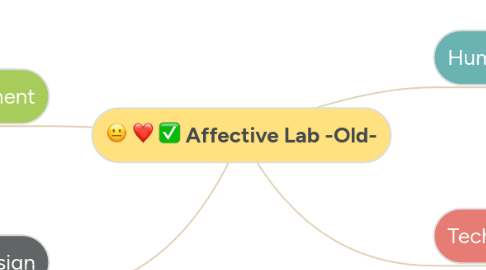
1. Management
1.1. Relationship Management
1.1.1. Personal Relation
1.1.1.1. "Influence of altruism to the party without reciprocity on society considering influence on the third party"
1.1.1.2. "Affect and Communication: Perspectives of Information and Emotion Communication"
1.1.1.3. "Factors Influencing People’s Perception on Appropriateness of Affect Communication"
1.1.1.4. "Influence of altruism to the party without reciprocity on society considering influence on the third party"
1.1.1.5. "The Approach of the Story Co-creating System for Developing Perspective-taking of Children"
1.1.1.6. Towards a better understanding of psychological states: A sensor-based approach to estimate human behavior
1.1.1.7. Unobtrusive estimation of psychological states based on human movement observation
1.1.2. Social Relation
1.1.2.1. Close to You: Awarness system to present information suggesting human being and existance with natural mapping
1.1.2.2. Identifying How a Group Member’s Behavior Influences Group Cohesion in Group Activities
1.1.2.3. Factors Influencing People’s Perception on Appropriateness of Affect Communication
1.1.2.4. An Exploration of Affective Factors Based on Text Mining Approaches
1.1.2.5. "Decision Making Process of “Air of the Place”: The Model and Development of the Measurement of the Processing Skill"
1.1.2.6. Factors determining the extent and consequence of emotional labor
1.1.2.7. Effects of Emotional Intelligence on Group Work Satisfaction
1.2. Marketing
1.2.1. The Japanese-expression effect: Specific Expressions Controls Decision Biases
1.2.2. Organization of Perceived Value of Products and Influences of Psychographic Factors on Perception of Product Value
1.2.3. Elements Constructing Omotenashi and Development of Omotenashi checklist
1.2.4. Defining Wow Marketing Communication Fators and Deelopment of Wow Marketing Communication Assesment Tool
1.2.5. Providing Customers with Affective Experiences: Perspectives for Design Factors and Management
1.3. Creativity
1.3.1. Effects of Talk on Creativity: Theory and Verification
1.3.2. Development of the Team Creative Efficacy Scale and Investigation of Factors Influencing on Team Creative Efficacy
1.3.3. Implementation of the moderate supporting system for divergent thinking by showing images continually with text-based genetic algorithm
1.4. Place
1.4.1. Defining “Igokochi” Factors and Development of “Igokochi” Assessment Tool
1.4.2. Affective Well-being in the Workplace: Perspectives of Top Management and Employee
1.5. Company Management
2. Human
2.1. Elderly
2.1.1. Older Adults’ Affective and Cognitive Factors and Information and Communication Technology
2.1.2. Older people and Computer media Communication technology in Shanghai Area
2.1.3. Effects of learning style and training method on technology acquisition of older adults
2.1.4. Technology acceptance model with social factors for older people.
2.2. Physiology
2.2.1. A study on the relationships between the performance of intuition and the state of the physical activity
2.2.2. A study on time-estimation model and its individual difference factors in mental task
2.2.3. Towards a better understanding of psychological states: A sensor-based approach to estimate human behavior
2.3. Personality
2.3.1. AMANOJYAKU behavior: Systematization of “amanojyaku behavior” and the relationships between “Amanojyaku behavior” and the personality
2.3.2. Influence of Pessimism and Mental Toughness on Depression Trend and Mass
2.4. Solo
2.4.1. To establish hamaru process model and to investigate the motivations in the hamaru process
3. Design
3.1. Proposal of a Framework to Design/Evaluate User Experience
3.2. A study on similarity judgments in design rights infringement cases
3.3. Detection of emotional responses to visual stimuli based on pupil size changes
4. Technology
4.1. Robot
4.1.1. Elements Constructing People's Attitude toward Robots and Development of Robot Attitude Scale
4.1.2. Elements Constructing People's Attitude toward Robots and Development of Robot Attitude Scale
4.1.3. Influences of robot attitudes and robot characteristics on people's acceptance of robots: International comparison among Japan, China and Taiwan
4.2. Elderly × Technology
4.2.1. Older Adults’ Affective and Cognitive Factors and Information and Communication Technology
4.2.2. Older people and Computer media Communication technology in Shanghai Area
4.2.3. Technology acceptance model with social factors for older people.
4.3. Human-Computer Interaction
4.3.1. Older Adults’ Affective and Cognitive Factors and Information and Communication Technology
4.3.2. Effectiveness of Advice Giving Methodolgy Based on Trainee's Exploratory Behavior Characteristics
4.3.3. Older people and Computer media Communication technology in Shanghai Area
4.3.4. Detection of computer users’ anxiety based on the time indices of mouse click operation.
4.3.5. Towards Better Technology Engagement and Well-being: Psychological Approaches
4.3.6. Personal factors influencing people's ICT interaction:A study of engagement,quality of experience, creativity and emotion
4.3.7. Age Differences in Personality Factors Influencing Usage of Computer-Mediated Communication
